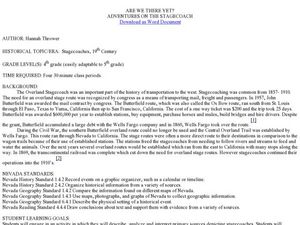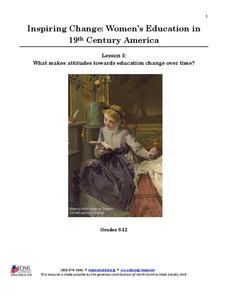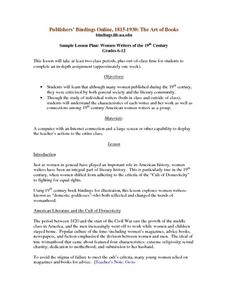C3 Teachers
Women’s Rights: What Does It Mean to Be Equal?
A guided-inquiry lesson asks seventh graders to research the compelling question, "What does it mean to be equal?" Guided by three supporting questions, researchers complete three formative performance tasks and gather evidence from...
Curated OER
Quilt Block Collage
Learn the art of quilting with this lesson plan that can be connected to a history lesson on quilts in Ancient Egypt, China, and modern art. After studying a general history of quilts, its uses, and the history of different patterns,...
National Endowment for the Humanities
The Music of African American History
High schoolers examine role spirituals have played in African American history and religion, examine Harriet Tubman's use of spirituals in her work, explore power of spirituals in Civil Rights Movement, and work with oral tradition,...
Curated OER
Bears and Panthers Aplenty: Early Settlers Make a Home in Arkansas
Young historians research the Southwest Trail, which ran through Arkansas back in the 19th century. Pupils are divided into four groups. Each group researches a pioneer who blazed the Southwest Trail. Then, the group presents an oral or...
Curated OER
19th Century Settlement Houses
Students will take notes on 19th century settlement houses using a four-door book of foldable notes. In this lesson on Settlement Houses, students will analyze the Hull House through a variety of primary sources, then create a list of...
Curated OER
Turn of the Century Immigration
Students explore the immigration wave that hit the United States in 19th century. In this immigration lesson, students examine primary and secondary sources to determine what the immigration experience was like for new citizens. Students...
Curated OER
Riding a Stagecoach in the 19th Century
Students research the differences between traveling on a stagecoach and wagon trail in the 19th century. In this historical lesson, students discover the uses of stagecoaches and wagon trails in the 19th century, then decide which one...
Anti-Defamation League
Analyzing Primary Source Documents to Understand U.S. Expansionism and 19th Century U.S.-Indian Relations
Historical events can be viewed from multiple perspectives. This simple truth is brought home in a lesson that examines primary source documents related to the Lewis and Clark Expedition, the Doctrine of Discovery and Manifest Destiny,...
Curated OER
Introduction to Reform Movements of the 1800s
Eleventh graders consider the impact of reform movements of the 19th century. In this Progressive Reform lesson, 11th graders examine documents and images associated with women's suffrage, prohibition, and labor reform. Students respond...
Curated OER
Inventions of the 19th Century
Young scholars explore inventions that have been created since the nineteenth century.
Constitutional Rights Foundation
History of Immigration From the 1850s to the Present
The Statue of Liberty may embrace the huddled masses of the world, but has American society always joined in? After young historians read a passage about the history of American immigration in the 19th and 20th centuries, focusing on...
Curated OER
Native American History
Learners examine how Chief Joseph attempted to challenge stereotypes about Native Americans. In this Native American history lesson, students read "An Indian's Views of Indian Affairs," and then paraphrase the selection. Learners also...
Curated OER
Reform in the Late 19th Century
Eleventh graders explore, examine, and study the concept of reform in the late 19th century in the United States. They explain the methods that social critics advocated to improve society and examine efforts to help the urban poor found...
Curated OER
The Art and Science of Impressionist Color
Discover Impressionist painting as learners investigate the 19th century combinations of colors characteristically used. Students experiment with their own paintings, utilizing primary and secondary colors.
Curated OER
Louis Pasteur & Germ Theory
Germ Theory revolutionized the medical industry and our understanding of bacteria and the human body. Presented is a series of facts and history on Louis Pasteur his discoveries and how they changed beliefs in the scientific community....
Curated OER
Modern Interpretations
To conclude an eight-lesson study of the events that occurred in the early colonial period in Deerfield, Massachussetss, class members evaluate the point of view and bias found in late 19th and early 20th century retellings.
National Society Daughters of the American Revolution
Lesson 3: What Makes Attitudes Towards Education Change over Time?
The struggle for women's rights is not unique to this generation, or even to the 20th century. Class members explore the conflicting opinions of Alexander Graham Bell and his wife, Mabel Hubbard Bell, regarding women's pursuits of higher...
Daughters of the American Revolution
Lesson 1: How Do Society’s Expectations Influence Education?
The history of women's education can be traced back to the delicate stitching of student samplers from the 19th century. Modern-day pupils examine and analyze four primary sources, three of which are images of embroidered samplers, which...
Daughters of the American Revolution
Lesson 2: How Do We Determine the Value of Education?
Have women always had the same educational opportunities as their male counterparts? Young historians read an 1819 essay by Emma Willard on the state of female education in the 19th century before discussing their views regarding women's...
Curated OER
The Great Military: Map of Texas
The battle at the Alamo may be one of the most famous military campaigns in Texas history, but it is by no means the only one. As part of their study of the military history of Texas, class members research less-well-known sites, locate...
Curated OER
Slave Narratives: Constructing U.S. History Through Analyzing Primary Sources
Learners access oral histories that contain slave narratives from the Library of Congress. They describe the lives of former slaves, sample varied individual experiences and make generalizations about their research in journal entries.
Curated OER
Writers of the 19th Century
Students are introduced to women authors during the 19th century. In groups, they read about the criticism they faced during this time period by the public and literary community. Using the internet, they research one author to...
Curated OER
A Case Study: Slavery and Anti-Slavery in Philadelphia, PA, (17th-19th Centuries)
Eleventh graders work in teams of three. Each team visits a workstation to interpret, analyze, and apply information from documents for their final project. The final project is an exhibit at Independence National Historic Park
Curated OER
French Realism and Its Place in History
Students can gain a greater understanding of 19th century Europe by focusing on French Realism.

























